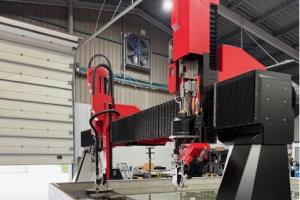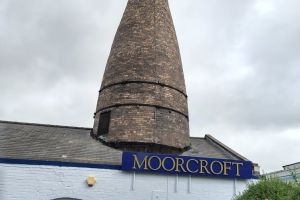Talking business: John van de Laarschot and Cllr Mohammed Pervez

In the latest in a series of ‘Talking Business’ interviews, John van de Laarschot, chief executive of Stoke-on-Trent City Council, and council leader Mohammed Pervez, chat to the editor of TheBusinessDesk.com, Andy Coyne, and KPMG’s head of public sector in the Midlands, Andy Argyle.
COMMENTJoining the dotsA RECENT LGA modelling*estimated that councils will face a 66 per cent funding shortfall by 2019/20 if core waste and social services remain fully funded. With figures such as these, it is clear that radical changes are needed if local authorities are to deliver quality services while at the same time avoid a funding crisis. We are already seeing some councils tackling this challenge head on by coming up with innovative strategies that aim to attract private sector capital. The traditional private sector ‘outsourcing’ experiences over recent years provide valuable insight and experience of what ‘works’ and what can be done better. The scale of the challenge means that public sector bodies, which have historically often worked in ‘silos,’ must ‘join the dots’ and explore how together they can change business models in ways which will help manage demand more effectively and reduce unit costs. In practice, this means that local authorities, housing associations, the education sector and the wider NHS will need to work together to identify and then redefine how citizens interact with services. It also means harnessing the third sector to play a greater role in delivering services in ever more creative ways. This type of integrated pathway will deliver core and essential services while at the same time producing the efficiency savings needed throughout the public sector. There are already examples of this type of citizen-focused cooperation, such as collaboration between health agencies and local authorities to address the challenges of delivering healthcare and social care in the community, thus allowing citizens to remain in their homes. In addition, local authorities are working with the further education sector around delivering targeted apprenticeship training schemes. There remains significant potential for more integrated working, both within existing geographical boundaries and between geographical areas. Local authorities as commissioners, influencers and co-ordinators have a key role to play – both in setting the strategic direction and making things happen.
*Local Government Chronicle, 28 June 2012 Andy Argyle, head of public sector at KPMG in the Midlands
|
STOKE-on-Trent’s economy has struggled for a number of years and for a number of reasons but now there seems to be genuine hope that things have taken a turn for the better. The team of council chief executive John van de Laarschot and council leader Mohammed Pervez is providing a degree of stability that has sometimes been lacking in the local authority and there are big plans to bring prosperity to the Potteries. The city has seen a marked decline in its manufacturing base over the last decade – although its traditional potteries industry seems to be enjoying something of a resurgence – and clear decision-making at the local government level has been hampered by the unique structure of the place. Five towns can often mean five lots of opinions. Stoke-on-Trent’s city centre has been badly in need of regeneration for many years but by the time it had all its ducks in a row the recession came along and large-scale property development – especially when linked to public sector spending – became especially difficult to get away. But van de Laarschot – a former Pepsi Cola executive who arrived in Stoke-on-Trent via Torridge District Council in North Devon – and Cllr Pervez (below) – a former voluntary community worker who is leader of the ruling Labour group on the council – are convinced that the city has a great future and are staking their professional and political reputations on it.
The council recently released its Mandate for Change – a blueprint for economic prosperity following a lengthy consultation period with local businesses. residents and partners. Councillor Pervez says: “We want to make Stoke-on-Trent the place to bring business and to support existing businesses so they can grow. “At launch last year we asked for feedback on whether people thought we were on the right track. We put that feedback into Mandate for Change and then over the last 12 months we have been acting on that feedback to help stimulate growth in Stoke- on-Trent. “The number one priority for the city is jobs. This is what the Mandate for Change is there to deliver.” Van de Laarschot adds: “The legacy of Stoke-on-Trent is of severe industrial decline in terms of coal, the activity around the potteries and in terms of steel. “Where a lot of northern cities have had the opportunity to re-engineer themselves, for whatever reason that hasn’t happened in Stoke-on-Trent. “With a new political regime coming on board and a period of stability now for four years, the administration has signed up to what is a pretty radical opportunity to transform the city by addressing the fundamental issues of worklesness. “We haven’t really been able to deliver against the worklessness agenda and to be fair as a local authority we aren’t the ones who can solve the problem. We’re not creating jobs; if anything we are reducing the size of our organisation year on year. “What we need to do is to create the right economic conditions for the private sector to be really successful. Now what we’ve got with Councillor Pervez and his administration is the political leadership to drive that agenda forward and what you are seeing across the city now is a growth of confidence. “We can evidence that from the amount of funding that is coming into the city and the number of businesses looking to re-invest and expand. “It’s a city that’s now on the up and you can feel it. That’s what the Mandate for Change is all about.” The key to attracting much-needed inward investment, though, is to provide a more attractive city centre working environment. To that end plans are in place for a new Central Business District, a new bus station, a new shopping centre and further development of the university quarter. To give the new office quarter a kick-start, Stoke-on-Trent City Council is to move to the planned Central Business District (CBD) where it will become the anchor tenant. The relocation – at a cost estimated at £40m – is intended to act as a catalyst to attract inward investors to the scheme. More than £37m will be spent building two purpose-built office blocks on the site of the former Unity House to house thousands of council staff. The Civic Centre and other council buildings will be sold to help fund the relocation. The move hasn’t received universal approval but Councillor Pervez says: “To kick-start the CBD, we’re having to put in £40m of our own money to say to the private sector that we’re serious about reviving our city. “If the Central Business District realises its full potential, we will create something in the region of 4,500 jobs.” His reasoning for such large-scale city centre redevelopment is simple. “At the moment we have a city centre that is not functioning properly. “We have a bus station that is currently being built. The site of the old bus station will be where a £350m private sector investment will go in: the creation of a brand new shopping centre. “These are the things we are doing to try and stimulate the city centre’s economy.” Critics of the council’s decision to move to the Central Business District suggest that moving such a large organisation from one part of the city to another doesn’t solve anything. Is the local authority also hoping businesses that have moved out of town to business parks will come back into the centre? Van de Laarschot says not. “We are not looking to end up with a huge amount of displacement from one part of the city to the Central Business District. That doesn’t make any sense at all,” he says. “We are getting interest from international companies that can see the benefit of moving into a city centre location which, in terms of the accommodation they are going to get, provides good rental value.” But does it make sense to build so much accommodation for white-collar inward investment businesses in a city that has traditionally been associated with blue-collar jobs and in an era when there is little inward investment of any kind about? Neither Cllr Pervez nor van de Laarschot accept the premise of that objection. Cllr Pervez says: “There is the short- term priority of creating blue collar jobs and the mid to long-term priority of creating white collar jobs. We have put £270m into rebuilding our secondary schools and are working closely with the universities to raise aspirations. “We need to retain our graduates and the Central Business District and a viable city centre will help to deliver that.” Van de Laarschot agrees. “The starting point is changing the perception of the city. Historically it had a perception that it was closed for business. We have re- engineered our whole planning regime so we say yes to development,” he says. “The aspirations are pretty clear. Making it a key city and having all the infrastructure in there so it can support the hinterland with a destination city that makes economic sense. That’s what we are trying to put together. “We need to have a retail provision that is commensurate with the scale of the city, a business district that is commensurate with the scale of the city and have the infrastructure in place to provide the cultural offer and employment opportunities.” The council also has plans to move Stoke-on-Trent towards being a sustainable city in terms of energy useage. Innovative plans include tapping into the potential of warm water which runs through disused mines. The thinking here is that such sustainability would tick boxes with potential inward investors and prove beneficial to ceramics businesses which are high users of water and energy. Van de Laarschot says: “There’s a complex mix and if you put it altogether you make a compelling business case for companies to come to a place where the sustainable energy supply is not totally dependent on the vagaries of the market. “On a city-wide basis we are looking at something like 550mw to be able to do it. On our preliminary analysis we could probably find the best part of 250-300mw through these creative ideas.” Van de Laarschot doesn’t subscribe to the view that there are no inward investors about. “It depends on where you look and what your proposition is,” he says. “The opportunities may be about getting on a plane to go to China and elsewhere. “The reality is that that’s where we are going to be doing our JVs in the future and that’s where the capital investment will come from.” Cllr Pervez adds: “We have to shout from the rooftops that Stoke-on-Trent is open for business. That’s the only way we will get any inward investment. “There isn’t much going around at the moment but we have to do as much as we can from a city council perspective.” Van de Laarschot is convinced that the council’s commitment to physical change can act as a catalyst for economic growth. “The new bus station and the Central Business District are not dependent on anyone else ,” he says. “In the current climate if you are really passionate about making change you have to put your money where your mouth is.”
SectorsCommentsIf you'd like to leave a comment, please register now for free or login
|



 A number of initiatives have been agreed by the council – some in conjunction with the area’s local enterprise partnership (LEP) – with the broad objectives of improving the city centre and its offering to would-be inward investors and of creating jobs.
A number of initiatives have been agreed by the council – some in conjunction with the area’s local enterprise partnership (LEP) – with the broad objectives of improving the city centre and its offering to would-be inward investors and of creating jobs.







